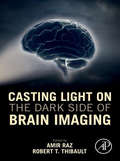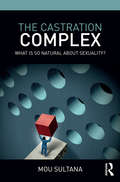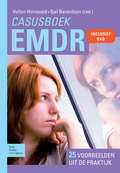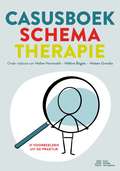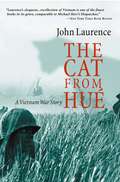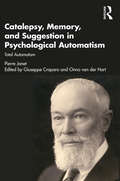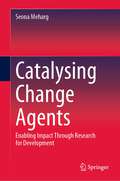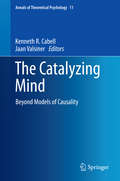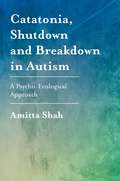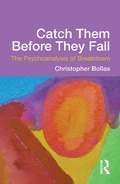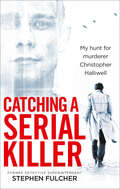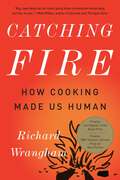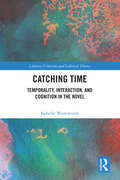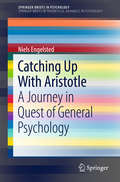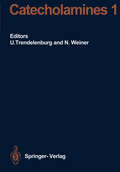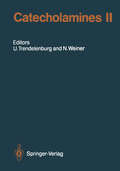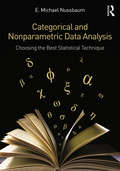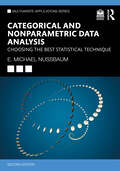- Table View
- List View
Casting Light on the Dark Side of Brain Imaging
by Amir Raz Robert T. ThibaultMost people find colorful brain scans highly compelling—and yet, many experts don’t. This discrepancy begs the question: What can we learn from neuroimaging? Is brain information useful in fields such as psychiatry, law, or education? How do neuroscientists create brain activation maps and why do we admire them? Casting Light on The Dark Side of Brain Imaging tackles these questions through a critical and constructive lens—separating fruitful science from misleading neuro-babble. In a breezy writing style accessible to a wide readership, experts from across the brain sciences offer their uncensored thoughts to help advance brain research and debunk the craze for reductionist, headline-grabbing neuroscience. This collection of short, enlightening essays is suitable for anyone interested in brain science, from students to professionals. Together, we take a hard look at the science behind brain imaging and outline why this technique remains promising despite its seldom-discussed shortcomings. Challenges the tendency toward neuro-reductionismDeconstructs hype through a critical yet constructive lensUnveils the nature of brain imaging dataExplores emerging brain technologies and future directionsFeatures a non-technical and accessible writing style
The Castration Complex: What is So Natural About Sexuality?
by Mou SultanaThis book illustrates that the Castration Complex and the question of the distinction between the sexes are enmeshed in psychoanalytic theories. The subjective negotiation of this distinction impacts the future sexual positions taken up (or not) by the subject, indicating that human sexuality is by no means a given or a natural occurrence in psychoanalysis. Engagement with the psychoanalytic theory of castration provides the reader with a different perspective on the current society’s insistence on gradually dissolving the differences between the sexes. For Freud, castration complex is the key to understanding the psychical consequences of the anatomical distinction between the sexes. For Lacan, castration introduces the subject to his/her very existence as a sexed being. Mou Sultana illustrates how these two revolutionary theorists came to such conclusions by close reading of the core texts, interpreting them and highlighting their relevance both within and outside the clinic of modern times.
The Castration Complex: What is So Natural About Sexuality?
by Mou SultanaThis book illustrates that the Castration Complex and the question of the distinction between the sexes are enmeshed in psychoanalytic theories. The subjective negotiation of this distinction impacts the future sexual positions taken up (or not) by the subject, indicating that human sexuality is by no means a given or a natural occurrence in psychoanalysis. Engagement with the psychoanalytic theory of castration provides the reader with a different perspective on the current society’s insistence on gradually dissolving the differences between the sexes. For Freud, castration complex is the key to understanding the psychical consequences of the anatomical distinction between the sexes. For Lacan, castration introduces the subject to his/her very existence as a sexed being. Mou Sultana illustrates how these two revolutionary theorists came to such conclusions by close reading of the core texts, interpreting them and highlighting their relevance both within and outside the clinic of modern times.
Casusboek EMDR: 25 Voorbeelden Uit De Praktijk
by Hellen Hornsveld Sjef BerendsenCirca twintig jaar geleden werd EMDR (Eye Movement Desensitisation and Reprocessing) ontwikkeld als behandelvorm voor Post Traumatische Stress Stoornissen (PTSS ). Na aanvankelijke scepsis is EMDR inmiddels opgenomen in (inter)nationale richtlijnen voor de behandeling van PTSS en wordt het ook bij veel andere klachtengebieden toegepast.Uit de praktijk: In Casusboek EMDR beschrijven 25 Nederlandse therapeuten aansprekende voorbeelden uit hun praktijk waarbij zij EMDR succesvol gebruikten. Daarmee gunnen zij de lezer een kijkje in de keuken van hun praktijk en nemen zij iets van het mysterie rond deze behandelmethode weg. De ervaringen van de beschreven cliënten tonen niet alleen de effectiviteit van EMDR aan, maar ook de efficiëntie van deze therapievorm.Op de dvd bij dit boek is tevens te zien hoe een therapiesessie verloopt en geven EMDR-therapeuten informatie over deze therapievorm.Wat is EMDR?EMDR is een effectieve en efficiënte methode die snel resultaten boekt, weinig dropouts kent en relatief mild is voor de patiënt. De praktijkvoorbeelden illustreren wat EMDR is: een protocollaire methode die volstrekt afwijkt van andere behandelvormen. De auteurs leggen daarom eerst uit wat EMDR is en volgen de ontwikkeling van deze therapie vanaf het begin.
Casusboek schematherapie: 21 voorbeelden uit de praktijk
by Hellen Hornsveld Hélène Bögels Heleen GrandiaDit boek laat psychologen, psychiaters en andere geïnteresseerden zien hoe schematherapie succesvol kan worden toegepast in de praktijk. Het toont wat de mogelijkheden zijn van deze therapiemethode, waarbij de nadruk ligt op de opbouw van de behandeling. In Casusboek Schematherapie – 21 voorbeelden uit de praktijk kan de lezer stapsgewijs volgen hoe een schematherapie van begin tot eind wordt vormgegeven. Daarbij is er aandacht voor verschillende soorten problemen en doelgroepen. Zo gaan de auteurs in op behandeling van cliënten met comorbiditeit (bijvoorbeeld PTSS of verslaving), en op verschillen in leeftijd en setting (zoals individueel, of in een groep). Telkens wordt uitgelegd hoe keuzes zijn gemaakt, hoe de indicatiestelling tot stand kwam, hoe het behandelplan werd samengesteld, en welke uitdagingen er waren om de therapie tot een goed einde te brengen. Daarbij wordt een onderscheid gemaakt in de conceptualisatiefase, herkenningsfase, veranderingsfase en de eindfase. Het boek biedt daarnaast praktische handvatten: elk hoofdstuk bevat aandachtspunten en tips over het onderwerp dat besproken is. De illustraties van Heleen Grandia maken het verhaal toegankelijk en brengen de soms ingewikkelde interne dynamiek helder in beeld. De samenstellers van dit boek zijn Hellen Hornsveld, Hélène Bögels en Heleen Grandia. Zij werken al jaren met schematherapie. Ze zijn actief in de Vereniging voor schematherapie en zijn als docent en supervisor betrokken bij het onderwijs in schematherapie.
The Cat From Hue: A Vietnam War Story
by John LaurenceWinner of the Overseas Press Club Cornelius Ryan AwardJohn Laurence covered the Vietnam war for CBS News from its early days, through the bloody battle of Hue in 1968, to the Cambodian invasion. He was judged by his colleagues to be the best television reporter of the war, however, the traumatic stories Laurence covered became a personal burden that he carried long after the war was over.In this evocative, unflinching memoir, laced with humor, anger, love, and the unforgettable story of Méo, a cat rescued from the battle of Hue, Laurence recalls coming of age during the war years as a journalist and as a man. Along the way, he clarifies the murky history of the war and the role that journalists played in altering its course.The Cat from Hué has earned passionate acclaim from many of the most renowned journalists and writers about the war, as well as from military officers and war veterans, book reviewers, and readers. This book will stand with Michael Herr's Dispatches, Philip Caputo's A Rumor of War, and Neil Sheehan's A Bright, Shining Lie as one of the best books ever written about Vietnam-and about war generally.
The Cat From Hue: A Vietnam War Story
by John LaurenceWinner of the Overseas Press Club Cornelius Ryan Award John Laurence covered the Vietnam war for CBS News from its early days, through the bloody battle of Hue in 1968, to the Cambodian invasion. He was judged by his colleagues to be the best television reporter of the war, however, the traumatic stories Laurence covered became a personal burden that he carried long after the war was over. In this evocative, unflinching memoir, laced with humor, anger, love, and the unforgettable story of Mé a cat rescued from the battle of Hue, Laurence recalls coming of age during the war years as a journalist and as a man. Along the way, he clarifies the murky history of the war and the role that journalists played in altering its course.The Cat from Huéi> has earned passionate acclaim from many of the most renowned journalists and writers about the war, as well as from military officers and war veterans, book reviewers, and readers. This book will stand with Michael Herr's Dispatches, Philip Caputo's A Rumor of War, and Neil Sheehan's A Bright, Shining Lie as one of the best books ever written about Vietnam-and about war generally.
Catalepsy, Memory and Suggestion in Psychological Automatism: Total Automatism
by Pierre JanetPierre Janet’s L'Automatisme psychologique, originally published in 1889, is one of the earliest and most important books written on the study of trauma and dissociation. Here it is made available, in two volumes, in English for the first time, with a new preface by Giuseppe Craparo and Onno van der Hart. Catalepsy, Memory, and Suggestion in Psychological Automatism, the first volume, examines three aspects of trauma and dissociation. Janet first explores catalepsy and analogous states, including comparing catalepsy to somnambulism, then discusses somnambulism, memory, and forgetting. Finally, Janet considers suggestion, amnesia, and distraction, as well as considering characteristics of suggestible individuals. Janet’s work is an unsurpassed experimental study of human actions in their simplest and most rudimentary forms, and a fundamental contribution to our understanding of trauma-related dissociation. This seminal work will be of great interest to researchers and students of psychoanalysis, philosophy, and modernism, as well as psychotherapists and psychoanalysts working with clients who have experienced trauma. It is accompanied by Subconscious Acts, Anesthesias, and Psychological Disaggregation in Psychological Automatism: Partial Automatism.
Catalepsy, Memory and Suggestion in Psychological Automatism: Total Automatism
by Pierre JanetPierre Janet’s L'Automatisme psychologique, originally published in 1889, is one of the earliest and most important books written on the study of trauma and dissociation. Here it is made available, in two volumes, in English for the first time, with a new preface by Giuseppe Craparo and Onno van der Hart. Catalepsy, Memory, and Suggestion in Psychological Automatism, the first volume, examines three aspects of trauma and dissociation. Janet first explores catalepsy and analogous states, including comparing catalepsy to somnambulism, then discusses somnambulism, memory, and forgetting. Finally, Janet considers suggestion, amnesia, and distraction, as well as considering characteristics of suggestible individuals. Janet’s work is an unsurpassed experimental study of human actions in their simplest and most rudimentary forms, and a fundamental contribution to our understanding of trauma-related dissociation. This seminal work will be of great interest to researchers and students of psychoanalysis, philosophy, and modernism, as well as psychotherapists and psychoanalysts working with clients who have experienced trauma. It is accompanied by Subconscious Acts, Anesthesias, and Psychological Disaggregation in Psychological Automatism: Partial Automatism.
Catalysing Change Agents: Enabling Impact Through Research for Development
by Seona MehargThis book provides an overview of the challenges and opportunities for creating positive systemic change through research for development projects, providing four real-world examples. Practical insights are offered on identifying and cultivating change agents through your projects and programs, increasing the likelihood of enduring success. Understanding and participating in these types of interventions enable researchers and practitioners to become better agents of change themselves.
The Catalyzing Mind: Beyond Models of Causality (Annals of Theoretical Psychology #11)
by Kenneth R. Cabell Jaan ValsinerHow do we understand and explain phenomena in psychology? What does the concept of “causality” mean when we discuss higher psychological functions and behavior? Is it possible to generate “laws” in a psychological and behavioral science—laws that go beyond statistical regularities, frequencies, and probabilities? An international group of authors compare and contrast the use of a causal model in psychology with a newer model—the catalytic model. The Catalyzing Mind: Beyond Models of Causality proposes an approach to the qualitative nature of psychological phenomena that focuses on the psychological significance and meaning of conditions, contexts, and situations as well as their sign-mediating processes. Contributors develop, apply, and criticize the notion of a catalyzing mind in hopes of achieving conceptual clarity and rigor. Disciplines such as philosophy, psychology, semiotics and biosemiotics are used for an interdisciplinary approach to the book. Research topics such as history and national identity, immigration, and transitions to adulthood are all brought into a dialogue with the concept of the catalyzing mind. With a variety of disciplines, theoretical concepts, and research topics this book is a collective effort at an approach to move beyond models of causality for explaining and understanding psychological phenomena.
Catatonia, Shutdown and Breakdown in Autism: A Psycho-Ecological Approach
by Amitta ShahThis ground-breaking book provides the first detailed clinical analysis of the various manifestations of catatonia, shutdown and breakdown in autistic individuals, with a new assessment framework (ACE-S) and guidance on intervention and management strategies using a psycho-ecological approach. Based on Dr Amitta Shah's lifetime of clinical experience in Autism Spectrum Disorders, and her research in collaboration with Dr Lorna Wing, this much needed book will be a valuable resource for professionals, autistic individuals and their families and carers.
Catatonia, Shutdown and Breakdown in Autism: A Psycho-Ecological Approach
by Amitta ShahThis ground-breaking book provides the first detailed clinical analysis of the various manifestations of catatonia, shutdown and breakdown in autistic individuals, with a new assessment framework (ACE-S) and guidance on intervention and management strategies using a psycho-ecological approach. Based on Dr Amitta Shah's lifetime of clinical experience in Autism Spectrum Disorders, and her research in collaboration with Dr Lorna Wing, this much needed book will be a valuable resource for professionals, autistic individuals and their families and carers.
Catch Them Before They Fall: Psychoanalysis Of Mental Breakdown
by Christopher BollasIn this exploration of a radical approach to the psychoanalytical treatment of people on the verge of mental breakdown, Christopher Bollas offers a new and courageous clinical paradigm. He suggests that the unconscious purpose of breakdown is to present the self to the other for transformative understanding; to have its core distress met and understood directly. If caught in time, a breakdown can become a breakthrough. It is an event imbued with the most profound personal significance, but it requires deep understanding if its meaning is to be released to its transformative potential. Bollas believes that hospitalization, intensive medication and CBT/DBT all negate this opportunity, and he proposes that many of these patients should instead be offered extended, intensive psychoanalysis. This book will be of interest to clinicians who find that, with patients on the verge of breakdown, conventional psychoanalytical work is insufficient to meet the emerging crisis. However, Bollas’s challenging proposal will provoke many questions and in the final section of the book some of these are raised by Sacha Bollas and presented in a question-and-answer form.
Catch Them Before They Fall: Psychoanalysis Of Mental Breakdown
by Christopher BollasIn this exploration of a radical approach to the psychoanalytical treatment of people on the verge of mental breakdown, Christopher Bollas offers a new and courageous clinical paradigm. He suggests that the unconscious purpose of breakdown is to present the self to the other for transformative understanding; to have its core distress met and understood directly. If caught in time, a breakdown can become a breakthrough. It is an event imbued with the most profound personal significance, but it requires deep understanding if its meaning is to be released to its transformative potential. Bollas believes that hospitalization, intensive medication and CBT/DBT all negate this opportunity, and he proposes that many of these patients should instead be offered extended, intensive psychoanalysis. This book will be of interest to clinicians who find that, with patients on the verge of breakdown, conventional psychoanalytical work is insufficient to meet the emerging crisis. However, Bollas’s challenging proposal will provoke many questions and in the final section of the book some of these are raised by Sacha Bollas and presented in a question-and-answer form.
Catching a Serial Killer: My hunt for murderer Christopher Halliwell
by Stephen Fulcher'The gripping allure of long-form podcasts, such as Serial' Observer On the evening of Saturday, 19 March 2011, D.S. Stephen Fulcher receives a life-changing call that thrusts him into a race against the clock to save missing 22-year-old Sian O’Callaghan, who was last seen at a nightclub in Swindon. Steve knows from experience that he has a small window of time to find Sian alive, but his hopes are quickly dashed when his investigation leads him to Christopher Halliwell, a cabbie with sick obsessions. Following the investigation as it develops hour-by-hour, Steve’s gripping inside story of the cat-and-mouse situation that ensues shows how he hunted down Halliwell – his number-one suspect – which led him to the discovery of Sian’s body and another victim, Becky Godden-Edwards, who had been missing since 2002. The murders shocked the nation and Halliwell become one of the most hated men in Britain. Since then, he has been linked to several murders and disappearances, and has been called 'sick in the head' by an ex-cellmate for his unrelenting hatred of women.Catching a Serial Killer is a thrilling, devastating and absorbing look at a real-life murder case and potentially one of the UK’s most prolific serial killers.
Catching Fire: How Cooking Made Us Human
by Richard WranghamThe groundbreaking theory of how fire and food drove the evolution of modern humansEver since Darwin and The Descent of Man, the evolution and world-wide dispersal of humans has been attributed to our intelligence and adaptability. But in Catching Fire, renowned primatologist Richard Wrangham presents a startling alternative: our evolutionary success is the result of cooking. In a groundbreaking theory of our origins, Wrangham shows that the shift from raw to cooked foods was the key factor in human evolution. Once our hominid ancestors began cooking their food, the human digestive tract shrank and the brain grew. Time once spent chewing tough raw food could be sued instead to hunt and to tend camp. Cooking became the basis for pair bonding and marriage, created the household, and even led to a sexual division of labor. In short, once our ancestors adapted to using fire, humanity began. Tracing the contemporary implications of our ancestors' diets, Catching Fire sheds new light on how we came to be the social, intelligent, and sexual species we are today. A pathbreaking new theory of human evolution, Catching Fire will provoke controversy and fascinate anyone interested in our ancient origins-or in our modern eating habits.
Catching Time: Temporality, Interaction, and Cognition (Literary Criticism and Cultural Theory)
by Isabelle Wentworth'Time travels in divers paces with divers people.' Shakespeare’s oft-quoted line contains a hidden ambiguity: not only do individual people experience time differently, but time travels in diverse paces when we are with diverse persons. The line articulates a contemporary understanding of subjective time: it is changed by interaction with our social environment. Interacting with other people—and even literary characters—can slow or quicken the experience of time. Interactive time, and the paradigm of enactive cognition in which it sits, calls for an expansion of traditional ideas of time in narrative. The first book-length study of interactive time in narrative, Catching Time explains how lived time and narrative time interpenetrate each other, so that the relational model of subjective time acts as a narrative function. Catching Time develops a novel, interdisciplinary framework, drawing on cognitive science, narratology, and linguistics, to understand the patterns of temporality that shape narrative.
Catching Time: Temporality, Interaction, and Cognition (Literary Criticism and Cultural Theory)
by Isabelle Wentworth'Time travels in divers paces with divers people.' Shakespeare’s oft-quoted line contains a hidden ambiguity: not only do individual people experience time differently, but time travels in diverse paces when we are with diverse persons. The line articulates a contemporary understanding of subjective time: it is changed by interaction with our social environment. Interacting with other people—and even literary characters—can slow or quicken the experience of time. Interactive time, and the paradigm of enactive cognition in which it sits, calls for an expansion of traditional ideas of time in narrative. The first book-length study of interactive time in narrative, Catching Time explains how lived time and narrative time interpenetrate each other, so that the relational model of subjective time acts as a narrative function. Catching Time develops a novel, interdisciplinary framework, drawing on cognitive science, narratology, and linguistics, to understand the patterns of temporality that shape narrative.
Catching Up With Aristotle: A Journey in Quest of General Psychology (SpringerBriefs in Psychology)
by Niels EngelstedThis Brief presents the argument for the need to re-establish the theoretical focus of general psychology in contemporary psychological research. It begins with a detailed account of the current “crisis” of psychology and our modern disconnect from general psychology. Chapters present the works of Aristotle and A.N. Leontiev, using their ideas to outline a long wanted general psychology. The general psychology delineates the four corner posts of the domain of psychology: Sentience, Intentionality, Mind, and Human Consciousness, and explains why they are all necessary but not the same. Besides a historical discussion, which aims to demonstrate how Marxism got it right, and then not, this Brief presents a new radical theory of human evolution, which credits the Adam-and-Eve story with a vital link hitherto missed by Marxism, Darwinism, and paleoanthropology. In addition, it argues why a new understanding is important in the Anthropocene Age. Catching Up with Aristotle will be of interest to psychologists, undergraduate and graduate students, and researchers.
Catecholamines I (Handbook of Experimental Pharmacology #90 / 1)
by H. Bönisch J.P.M. Finberg W. W. Fleming K. H. Graefe S. Z. Langer J. Lehmann H. Matthaei P. B. Molinoff A. Philippu K. F. Tipton U. Trendelenburg D. P. Westfall H. Winkler B. B. Wolfe M.B.H. YoudimCatecholamines are important transmitter substances in the autonomic and central nervous systems. These two volumes provide a comprehensive presentation of the state-of-the-art of catecholamine research and development in the past 15 years. The volumes present in-depth reviews of topical areas of catecholamine research in which substantial progress has been made and which are of current interest to various theoretical and clinical disciplines. Each topic has been dealt with by an established expert. Clinical subjects of relevant importance are included. Catecholamines are of interest in pharmacology, physiology, biochemistry, as well as in neurology, psychiatry, internal medicine (cardiology, hypertension, asthma), ophthalmology and anesthesiology.
Catecholamines II (Handbook of Experimental Pharmacology #90 / 2)
by M. A. Arnold G. Bartholini I. B. Black F. E. Bloom M. J. Brownstein M. E. Conolly G. M. Jonakait G. F. Koob I. J. Kopin J. B. Martin J. M. Masserano M. Palkovits J. L. Reid P. C. Rubin J. M. Saavedra B. Scatton J. A. Schulman A. W. Tank P. R. Vulliet N. Weiner R. M. Weinshilboum B. ZikovicCatecholamines are important transmitter substances in the autonomic and central nervous systems. These two volumes provide a comprehensive presentation of the state-of-the-art of catecholamine research and development in the past 15 years. The volumes present in-depth reviews of topical areas of catecholamine research in which substantial progress has been made and which are of current interest to various theoretical and clinical disciplines. Each topic has been dealt with by an established expert. Clinical subjects of relevant importance are included. Catecholamines are of interest in pharmacology, physiology, biochemistry, as well as in neurology, psychiatry, internal medicine (cardiology, hypertension, asthma), ophthalmology and anesthesiology.
Categorical and Nonparametric Data Analysis: Choosing the Best Statistical Technique
by E. Michael NussbaumFeaturing in-depth coverage of categorical and nonparametric statistics, this book provides a conceptual framework for choosing the most appropriate type of test in various research scenarios. Class tested at the University of Nevada, the book's clear explanations of the underlying assumptions, computer simulations, and Exploring the Concept boxes help reduce reader anxiety. Problems inspired by actual studies provide meaningful illustrations of the techniques. The underlying assumptions of each test and the factors that impact validity and statistical power are reviewed so readers can explain their assumptions and how tests work in future publications. Numerous examples from psychology, education, and other social sciences demonstrate varied applications of the material. Basic statistics and probability are reviewed for those who need a refresher. Mathematical derivations are placed in optional appendices for those interested in this detailed coverage. Highlights include the following: Unique coverage of categorical and nonparametric statistics better prepares readers to select the best technique for their particular research project; however, some chapters can be omitted entirely if preferred. Step-by-step examples of each test help readers see how the material is applied in a variety of disciplines. Although the book can be used with any program, examples of how to use the tests in SPSS and Excel foster conceptual understanding. Exploring the Concept boxes integrated throughout prompt students to review key material and draw links between the concepts to deepen understanding. Problems in each chapter help readers test their understanding of the material. Emphasis on selecting tests that maximize power helps readers avoid "marginally" significant results. Website (www.routledge.com/9781138787827) features datasets for the book's examples and problems, and for the instructor, PowerPoint slides, sample syllabi, answers to the even-numbered problems, and Excel data sets for lecture purposes. Intended for individual or combined graduate or advanced undergraduate courses in categorical and nonparametric data analysis, cross-classified data analysis, advanced statistics and/or quantitative techniques taught in psychology, education, human development, sociology, political science, and other social and life sciences, the book also appeals to researchers in these disciplines. The nonparametric chapters can be deleted if preferred. Prerequisites include knowledge of t tests and ANOVA.
Categorical and Nonparametric Data Analysis: Choosing the Best Statistical Technique
by E. Michael NussbaumFeaturing in-depth coverage of categorical and nonparametric statistics, this book provides a conceptual framework for choosing the most appropriate type of test in various research scenarios. Class tested at the University of Nevada, the book's clear explanations of the underlying assumptions, computer simulations, and Exploring the Concept boxes help reduce reader anxiety. Problems inspired by actual studies provide meaningful illustrations of the techniques. The underlying assumptions of each test and the factors that impact validity and statistical power are reviewed so readers can explain their assumptions and how tests work in future publications. Numerous examples from psychology, education, and other social sciences demonstrate varied applications of the material. Basic statistics and probability are reviewed for those who need a refresher. Mathematical derivations are placed in optional appendices for those interested in this detailed coverage. Highlights include the following: Unique coverage of categorical and nonparametric statistics better prepares readers to select the best technique for their particular research project; however, some chapters can be omitted entirely if preferred. Step-by-step examples of each test help readers see how the material is applied in a variety of disciplines. Although the book can be used with any program, examples of how to use the tests in SPSS and Excel foster conceptual understanding. Exploring the Concept boxes integrated throughout prompt students to review key material and draw links between the concepts to deepen understanding. Problems in each chapter help readers test their understanding of the material. Emphasis on selecting tests that maximize power helps readers avoid "marginally" significant results. Website (www.routledge.com/9781138787827) features datasets for the book's examples and problems, and for the instructor, PowerPoint slides, sample syllabi, answers to the even-numbered problems, and Excel data sets for lecture purposes. Intended for individual or combined graduate or advanced undergraduate courses in categorical and nonparametric data analysis, cross-classified data analysis, advanced statistics and/or quantitative techniques taught in psychology, education, human development, sociology, political science, and other social and life sciences, the book also appeals to researchers in these disciplines. The nonparametric chapters can be deleted if preferred. Prerequisites include knowledge of t tests and ANOVA.
Categorical and Nonparametric Data Analysis: Choosing the Best Statistical Technique (Multivariate Applications Series)
by E. Michael NussbaumNow in its second edition, this book provides a focused, comprehensive overview of both categorical and nonparametric statistics, offering a conceptual framework for choosing the most appropriate test in various scenarios. The book’s clear explanations and Exploring the Concept boxes help reduce reader anxiety. Problems inspired by actual studies provide meaningful illustrations of these techniques. Basic statistics and probability are reviewed for those needing a refresher with mathematical derivations placed in optional appendices.Highlights include the following:• Three chapters co-authored with Edgar Brunner address modern nonparametric techniques, along with accompanying R code.• Unique coverage of both categorical and nonparametric statistics better prepares readers to select the best technique for particular research projects.• Designed to be used with most statistical packages, clear examples of how to use the tests in SPSS, R, and Excel foster conceptual understanding.• Exploring the Concept boxes integrated throughout prompt students to draw links between the concepts to deepen understanding.• Fully developed Instructor and Student Resources featuring datasets for the book's problems and a guide to R, and for the instructor PowerPoints, author's syllabus, and answers to even-numbered problems.Intended for graduate or advanced undergraduate courses in categorical and nonparametric statistics taught in psychology, education, human development, sociology, political science, and other social and life sciences.
